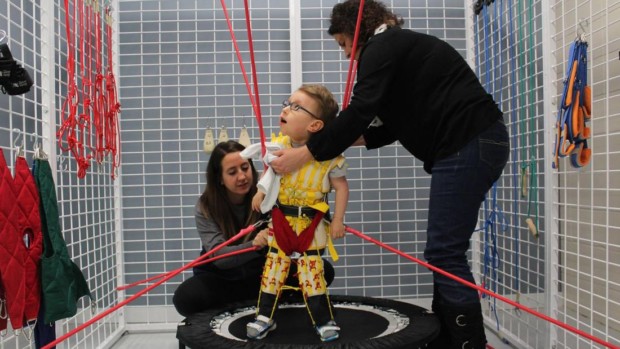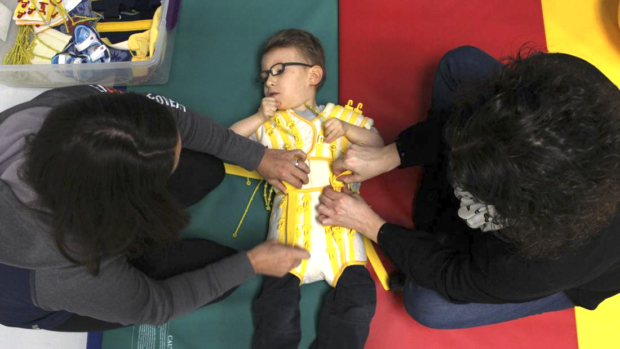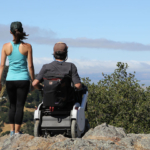Seeking one giant leap for a child’s mobility
With public programs stretched, some parents are turning to private therapies to help kids overcome mobility problems – but the jury is still out on their effectiveness.

Therapist Sandi Marshall (left) and mother Nancy Grant (right) strap Hunter Grant (centre) into his TheraSuit and onto a trampoline for part of his physiotherapy. Tiffany Cassidy, The Globe and Mail
Tiffany Cassidy, Special to The Globe and Mail Updated November 12, 2017
Like many three-year-olds, Hunter Grant likes to strap on his spacesuit and pretend to be an astronaut. But Hunter’s suit is for more than just imaginary rocket rides.
On a typical day, Hunter lays still on the floor of a Regina physiotherapy clinic while his mother and an exercise therapist pull the suit’s fabric base layer over his body and connect a series of yellow elastic rubber bands stretching from his feet to his torso. Once geared up, they place him on a trampoline and hook supportive ropes to the suit to keep him standing. He blasts off and takes mini-jumps, even if his muscles aren’t powerful enough to let his feet leave the mat.
For Hunter, resistance from the bands is intended to give him feedback every time he moves, improving his body alignment and adding a workout for his muscles. Hunter has a rare congenital disorder called agenesis of the corpus callosum, meaning the connection between the two hemispheres of his brain didn’t develop normally. His low muscle tone makes it challenging for him to sit without falling over, making rolling and crawling future goals.
His mother, Nancy Grant, had been looking for a therapy to help him increase muscle tone, strength and general development, and was excited to learn about a new program that uses a special suit to work with kids with neuromotor difficulties, including cerebral palsy, traumatic brain injuries and developmental delays.
Called the TheraSuit, it is modelled after gear previously worn by astronauts, which provided extra resistance on space missions to counter the effects of weightlessness. The price of the six-week therapy program was steep: $5,500 for three hours a day, five days a week. Grant covered the cost through a steak night, door prizes, 50/50 sales and donations.
“If there’s hope for my little guy to reach his highest potential, and if I can get him there, I’ll do anything,” Grant said.
The TheraSuit was developed by Izabela and Richard Koscielny, two physical therapists based in the United States whose daughter has cerebral palsy. In a report on their company’s website, they say that after struggling to get their daughter to independence, they tried a therapy that used an older version of the spacesuit originally created for the Russian space program – and she took her first steps at the end of the first session. The suit wasn’t for sale and was cumbersome, so they made their own modified design. The two patented the suit design in 2002, and it’s now available in more than 400 centres across the world.
While only available in private clinics in Canada, some U.S. hospitals use it, including Johns Hopkins All Children’s Hospital. The fourth Canadian TheraSuit program recently began at First Steps Wellness, a non-profit clinic in Hunter’s hometown of Regina. The clinic says the price tag for parents just covers its overhead costs.
Centres offering the program have posted online testimonials from parents raving about the therapy, including one story of a 14-year-old girl in the Toronto centre being able to use her left hand for the first time.
Yet, despite the program’s growth, the benefits of the suit itself are still being debated by researchers.

Therapist Sandi Marshall (left) and mother Nancy Grant (right) strap Hunter Grant (centre) into his TheraSuit. Tiffany Cassidy, The Globe and Mail
Even with available public therapy, many parents are choosing to leave or supplement that therapy with costly private treatments. Accessing private care usually means paying out of pocket, or possibly having coverage through additional health insurance.
The Cincinnati Children’s Hospital Medical Centre conducted a randomized controlled trial of the therapy, published in the journal Pediatric Physical Therapy in summer, 2011. It compared the outcomes of 20 children with cerebral palsy, who were randomized into two groups, one wearing the elastic bands with the suits, and a control group wearing the fabric layers with no elastic bands attached. Children in both groups showed improved scores in gross motor function and increased weight, and both results were statistically significant. But the improvements for the children without elastic bands were just as good as those with the full TheraSuit.
“Spending a lot of money and spending a lot of time on something that isn’t producing a benefit different than a controlled different therapy, it does not seem like a place to focus your efforts,” said Amy Bailes, assistant professor at the University of Cincinnati and the research physical therapist at the hospital who led the study.
Most Canadian provinces supply a limited amount of physiotherapy for children. Health ministries say it depends on a child’s needs as determined by the health-care provider, and also the available resources. Most provinces only pay for care inside the public system. In Saskatchewan, Grant was given two one-hour sessions a month in the public system.
Dr. Peter Rosenbaum is a professor of paediatrics at McMaster University and co-founder of the CanChild Centre for Childhood Disability Research. Parents sometimes tell him they are trying therapies outside the public system, and he says it happens across the country. He thinks they want to leave no stone unturned. He says research shows that more than 50 per cent of American children with neurodevelopmental conditions will be exposed to complementary and alternative methods of treatment, and he expects the same in Canada.
He has seen some cases of fraudulent treatment, but also some effective treatments that aren’t currently incorporated into mainstream medicine. “The challenge for, if you will, the mainstream system is to have evidence with which to embrace a new idea.”
Bailes, the Cincinnati researcher who has been investigating the therapy, says the high intensity of the program is new among available children’s therapy.
“Just like if you wanted to be a baseball player, if you intensively practice it, you get better,” she says. “But with children with [cerebral palsy] any activity that gives them a lot of opportunities to practice a skill is good. Then the question becomes: well, how much practice do you need? Does it need to be four hours a day, five days a week, for three weeks? We don’t know the answer to that question. What’s the threshold level of practice or the dose that a child needs to make changes?”

Nancy Grant plays with her three-year-old son Hunter Grant during his TheraSuit program. Tiffany Cassidy, The Globe and Mail
For Grant, the two days a month she spent in the public system wasn’t enough to get Hunter where she wanted him to be.
“They just sort of equip you with his handicap; your wheelchairs, and all of your stuff that you’re going to need for your handicapped child,” she said. “They don’t help him to really develop.”
The big goal at the beginning of Hunter’s TheraSuit program was to have him independently sitting. He almost made it there, but not quite. He still needs a bit of support with his balance, but Grant says his core is stronger and he’s better at catching himself when falling.
Grant and the staff saw more than just physical improvements. They saw developments in his speech, and for the first time heard him start to form clear sounds. “Is he going ‘mom’ exactly? No, but in my head he is.”
That’s enough for her to celebrate.
Grant and Hunter took a couple of months off since their first round of TheraSuit therapy, as is typical. Grant says she can see his regression. She says he’s not as interested in sitting any more and is losing some of the strength or confidence he gained.
In February they’ll start the program full-time again. It’s still not settled where exactly the money will come from, but Grant says she’s saving up and has a lot of help from her family.
“We want to go for as long as we can and give him the best shot,” she says.
Of course she would love to see him running around, but her goal is mobility. To her this could mean being able to stand up from a wheelchair and swing over to a chair.
“It’s hard to put a price limit on your child and his mobility and where he might go.”
 Source The Globe and Mail
Source The Globe and Mail
| References |
The effect of suit wear during an intensive therapy program in children with cerebral palsy, Bailes AF, Greve K, Burch CK, Reder R, Lin L, Huth MM. Pediatr Phys Ther. 2011 Summer;23(2):136-42. doi: 10.1097/PEP.0b013e318218ef58.
| TheraSuit® Treatment at Reeves Rehabilitation, San Antonio TX. The TheraSuit® treatment method uses specific exercises and equipment to improve range of motion, posture, balance, flexibility and functionality. The main device used in this method is called a TheraSuit®. This soft brace enhances posture control to allow isolated exercises within normal pattern of movement. University Health. Youtube Mar 6, 2010 |
Also see
TheraSuit® Method for Children University Health System
Therasuit Method Intensive Program (TMIP) Johns Hopkins All Children’s Hospital






